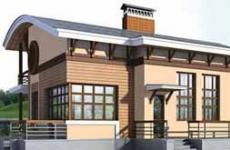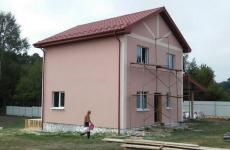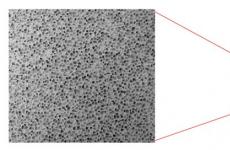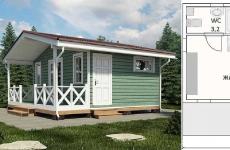Operating temperature of the heating boiler. Optimal boiler temperature. Ways to normalize the temperature regime of heating
After installing the heating system, it is necessary to adjust the temperature regime. This procedure must be carried out in accordance with existing standards.
The requirements for the temperature of the coolant are set out in normative documents that establish the design, installation and use engineering systems residential and public buildings. They are described in the State building codes and regulations:
- DBN (B. 2.5-39 Heat networks);
- SNiP 2.04.05 "Heating, ventilation and air conditioning".
For the calculated temperature of the water in the supply, the figure is taken that is equal to the temperature of the water at the outlet of the boiler, according to its passport data.
For individual heating, it is necessary to decide what the temperature of the coolant should be, taking into account such factors:
- Beginning and end heating season according to the average daily temperature outside +8 °C for 3 days;
- The average temperature inside the heated premises of housing and communal and public importance should be 20 ° C, and for industrial buildings 16°C;
- The average design temperature must comply with the requirements of DBN V.2.2-10, DBN V.2.2.-4, DSanPiN 5.5.2.008, SP No. 3231-85.
According to SNiP 2.04.05 "Heating, ventilation and air conditioning" (clause 3.20), the coolant limit values are as follows:

Depending on the external factors, the water temperature in the heating system can be from 30 to 90 °C. When heated above 90 ° C, dust begins to decompose and paintwork. For these reasons sanitary norms prohibit more heating.
To calculate the optimal indicators, special graphs and tables can be used, in which the norms are determined depending on the season:
- With an average value outside the window of 0 °С, the supply for radiators with different wiring is set at a level of 40 to 45 °С, and the return temperature is from 35 to 38 °С;
- At -20 °С, the supply is heated from 67 to 77 °С, while the return rate should be from 53 to 55 °С;
- At -40 ° C outside the window for all heating devices set the maximum allowable values. At the supply it is from 95 to 105 ° C, and at the return - 70 ° C.
Optimal values in an individual heating system
H2_2Heating system helps to avoid many problems that arise with a centralized network, and the optimal temperature of the coolant can be adjusted according to the season. In the case of individual heating, the concept of norm includes the heat transfer of a heating device per unit area of the room where this device is located. The thermal regime in this situation is provided design features heating appliances.
It is important to ensure that the heat carrier in the network does not cool below 70 ° C. 80 °C is considered optimal. It is easier to control heating with a gas boiler, because manufacturers limit the possibility of heating the coolant to 90 ° C. Using sensors to adjust the gas supply, the heating of the coolant can be controlled.
It is a little more difficult with solid fuel devices, they do not regulate the heating of the liquid, and can easily turn it into steam. And it is impossible to reduce the heat from coal or wood by turning the knob in such a situation. At the same time, the control of heating of the coolant is rather conditional with high errors and is performed by rotary thermostats and mechanical dampers.
Electric boilers allow you to smoothly adjust the heating of the coolant from 30 to 90 ° C. They are equipped with an excellent overheating protection system.
One-pipe and two-pipe lines
The design features of a single-pipe and two-pipe heating network determine different standards for heating the coolant.
For example, for a single-pipe line, the maximum rate is 105 ° C, and for a two-pipe line - 95 ° C, while the difference between the return and supply should be, respectively: 105 - 70 ° C and 95 - 70 ° C.
Matching the temperature of the heat carrier and the boiler
 Regulators help to coordinate the temperature of the coolant and the boiler. These are devices that create automatic control and correction of the return and supply temperatures.
Regulators help to coordinate the temperature of the coolant and the boiler. These are devices that create automatic control and correction of the return and supply temperatures.
The return temperature depends on the amount of liquid passing through it. The regulators cover the liquid supply and increase the difference between the return and supply to the level that is needed, and the necessary pointers are installed on the sensor.
If it is necessary to increase the flow, then a boost pump can be added to the network, which is controlled by a regulator. To reduce the heating of the supply, a “cold start” is used: that part of the liquid that has passed through the network is again transferred from the return to the inlet.
The regulator redistributes the supply and return flows according to the data taken by the sensor, and ensures strict temperature standards for the heating network.
Ways to reduce heat loss
 The above information will help to be used for the correct calculation of the coolant temperature norm and will tell you how to determine the situations when you need to use the regulator.
The above information will help to be used for the correct calculation of the coolant temperature norm and will tell you how to determine the situations when you need to use the regulator.
But it is important to remember that the temperature in the room is affected not only by the temperature of the coolant, outdoor air and the strength of the wind. The degree of insulation of the facade, doors and windows in the house should also be taken into account.
To reduce the heat loss of housing, you need to worry about its maximum thermal insulation. Insulated walls, sealed doors, metal-plastic windows help reduce heat loss. It will also reduce heating costs.
Hello, friends. What is the optimal mode of operation of a gas boiler? There are a number of contributing factors here. These are the conditions of its work, and the potential, and the design, etc.
The main motive for seeking a better regime is economic gain. At the same time, the equipment should give maximum efficiency, and fuel consumption is minimal.
Factors affecting the operation of the boiler
They are:
- Design. A technique can have 1 or 2 circuits. It can be wall or floor mounted.
- Normative and actual efficiency.
- Competent arrangement of heating. The power of technology is comparable to the area that needs to be heated.
- Technical conditions of the boiler.
- Gas quality.
All these points need to be optimized so that the device gives the best efficiency,
Design question.

The device can have 1 or 2 circuits. The first option is complemented by an indirect heating boiler. The second already has everything you need. And the key mode in it is to provide hot water. When water is supplied, heating is completed.
Wall-mounted models have less power than those placed on the floor. And they can heat a maximum of 300 sq.m. If your living area is larger, you will need a floor standing unit.
P.2 efficiency factors.

The document for each boiler reflects the standard parameter: 92-95%. For condensation modifications - approximately 108%. But the actual parameter is usually lower by 9-10%. It decreases even more due to heat losses. Their list:
- Physical malaise. The reason is excess air in the apparatus when the gas is burned, and the temperature of the exhaust gases. The larger they are, the more modest the efficiency of the boiler.
- Chemical burn. What is important here is the amount of CO2 oxide that occurs when carbon is burned. Heat is lost through the walls of the apparatus.
Methods for increasing the actual efficiency of the boiler:
- Elimination of soot from the pipeline.
- Elimination of scale from the water circuit.
- Limit chimney draft.
- Adjust the position of the blower door so that the heat carrier acquires the maximum temperature.
- Elimination of soot in the combustion chamber.
- Installation of a coaxial chimney.
P.3 Questions on heating. As already noted, the power of the device necessarily correlates with the heating area. A smart calculation is needed. The specifics of the structure and potential heat losses are taken into account. It is better to entrust the calculation to a professional.
If the house is built according to building codes, the formula is 100 W per 1 sq.m. It turns out this table:
| Area (sq.m.) | Power. | ||
| Minimum | Maximum | Minimum | Maximum |
| 60 | 200 | 25 | |
| 200 | 300 | 25 | 35 |
| 300 | 600 | 35 | 60 |
| 600 | 1200 | 60 | 100 |
Acquire better boilers foreign production. Also in the advanced versions there are many useful options to help you achieve the optimal mode. One way or another, the optimal power of the device is in the range of 70-75% of the highest value.
technical conditions. To prolong the life of the device, remove soot and scale from internal parts in a timely manner.
The optimal mode of operation of a gas boiler to save gas is achieved by eliminating clocking. That is, you need to set the gas supply to the smallest value. The attached instructions will help you with this.
There is an aspect that cannot be influenced - this is the quality of the gas.
Methods for setting the optimal mode
Many devices are programmed for the temperature of the thermal carrier. When it reaches the required values, the unit briefly turns off. The user can set the temperature himself. The parameters also change depending on the weather. For example, the optimal mode of operation of a gas boiler in winter is obtained at values of 70-80 C. In spring and autumn - at 55 - 70 C.
V modern models there are temperature sensors, thermostats and auto-tuning modes.
Thanks to the thermostat, you can set the desired climate in the room. And the heat carrier will warm up and cool down with a specific intensity. At the same time, the device reacts to temperature fluctuations in the house and outside. This is the optimal mode of operation of the outdoor gas boiler. Although with the help of such devices it is possible to optimize the mounted model. At night, the parameters can be reduced by 1-2 degrees.
Thanks to these devices, gas is spent less by 20%.
If you want solid efficiency and savings from the boiler, purchase the desired model. The following are some examples.
Model examples
- Baksi.

The optimal mode of operation of this wall-mounted gas boiler is achieved as follows: small apartments indicators are set to F08 and F10. The modulation spectrum starts at 40% of the highest power. And the minimum possible operating mode is 9 kW.

Many models of this company are very economical and can work at low gas pressure. Pressure limits: 9 - 17 mbar. Suitable voltage range: 165 - 240 V.
- Vaillant.

Many devices of this brand work optimally under such conditions: power - 15 kW. Submission is placed at 50-60. The device works for 35 minutes, rests for 20 minutes.
- Ferroli.

Best conditions: 13 kW for heating, 24 kW for water heating.
- Mercury.

The water pressure in the network is a maximum of 0.1 MPa. The highest temperature indicator at the outlet section is 90 C, the nominal value of flue gases is at least 110 C. The vacuum downstream of the apparatus is a maximum of 40 Pa.
- Navien.

Basically, these are two-circuit units. Automation works here. The mode is self-configuring. Sets the room heating setting. There is a pump that can reduce the parameters by 4-5 degrees.
- Ariston.

The automatic mode setting also works. Often people choose models with the "Comfort-Plus" mode.
- Buderus.

Values are usually set on the feed: 40 - 82 C. The current parameter is usually reflected on the monitor. The most comfortable summer mode- at 75 C.
Conclusion
Thanks to gas boiler you can conveniently adjust the climate in the house. Especially if you use innovative technology with automatic modes and many useful options.
Gas equipment is ubiquitous in apartments and country houses. You independently regulate the equipment by setting comfortable temperature in room. So you are not dependent on utilities, you can save fuel as you see fit. But for the operation to be really economical, the correct setting of the gas boiler is important.
Why do you need the correct adjustment of equipment:
- To save resources.
- To make it comfortable to be in the room, use hot water.
- To extend the life of the equipment.
Need to start with right choice boiler, its power. Consider the features of the room: the number and area of windows, doors, the quality of insulation, wall materials. The minimum calculation is based on heat losses per unit of time. You will learn more about this in the article "".
gas boilers divided into single and double. The latter perform heating to the heating circuit and hot water supply (DHW). Single-circuit units provide only heating. Therefore, to obtain hot water, indirect heating boilers are installed.
According to the type of placement, the equipment is floor and wall. Placed on the floor, the units have more power. Therefore, they are used for large areas(from 300 m²). Installation is carried out only in separate rooms (boiler rooms). This Baxi models(""), Buderus (""), "", "".

Attachments ("Lux", "", "",) fit perfectly in small apartments in the kitchen. Therefore, it is important to take into account all the nuances of the location. From correct selection parameters depends on the comfort of the residents, as well as the durability of the boiler.
Power setting
Heating power depends on modulation gas burner. If you have chosen an electronically controlled device, then it includes a thermostat that is connected to a room thermometer. Adjustment occurs automatically: the thermometer measures the temperature in the room. As soon as it falls below comfortable, he gives a command to start the burner or increase the strength of the flame.
In normal mode, the thermometer controls the temperature in only one room. But if you install valves in front of each radiator, control will be in all rooms.
You can adjust the burner manually by operating the gas valve. This is true for atmospheric boilers with an open combustion chamber. So, in the Protherm "Gepard", "Proterm Bear" models, the valve is controlled by an electric motor. To change settings, you need to go to service menu. Most often, this is done by a specialist, and the user performs the actions indicated in the instructions.
But still, we will tell you how to call the hidden menu for adjustment.
Before entering the menu and setting up, do this:
- Open the taps on the batteries.
- Set the room thermostat to the highest setting.
- In the user settings, set the maximum temperature that you use in severe frosts. The burner always turns off when the reading reaches 5°C above the set value. For example, at +75 degrees, a shutdown will occur when it reaches 80 degrees.
- Cool the coolant to 30°C.
For Protherm Gepard:

- Hold down the Mode key on the panel. As soon as "0" appears on the display, set the value to 35 by pressing "+" and "-".
- Press Mode to confirm.
- As soon as d. 0, enter the line number in the menu. Do this with "+" and "-" d.(number). To set the maximum burner power, choose d.53, the minimum - d.52.
- Use Mode to navigate to parameter selection. Change it "+" "-".
- The installation receives an automatic confirmation.
- Return to the original menu - hold Mode.
During regulation, use the panel to monitor the change in flame and temperature rise.
For "Proterm Panther" actions are different:

- Press Mode for about 7 seconds.
- Using keys 2 (look at the picture above), enter code 35.
- Confirm your entry.
- As soon as d.00 appears on the left side of the screen, use the 2 buttons to enter the number.

- You can change the parameter on the right side of the screen using the 3 keys.
- After confirmation, press mode to exit the menu.
For Electrolux Quantum models:
- Unplug the appliance from the mains for a few seconds.
- After turning on the regulator, hold the red button for 15 seconds.
- As soon as P01 lights up on the display, press the red key until P07 appears.

- If the number 1 flashes after P07, then 38°C - 85°C is maintained. If it glows 4 - 60°С–85°С, 7 - 38°С–60°С.
- Use the "+" "-" knob to adjust the desired value.
- Switch off the boiler for a few seconds. Now it will automatically support the specified parameters.
How to program technology Viessmann ("Wiesman"), look at the video:
For Eurosit 630:
All the steps above are used to set the appliance in heating mode. Many users are faced with a problem when, in DHW mode, water of an unstable temperature comes out of the tap. To fix this, use our recommendations.
Hot water temperature changes
To regulate the water supply to comfortable levels, it is necessary to reduce the burner power.
- Open the mixer to switch the boiler to DHW mode.
- Set the temperature to 55°C.
- Go to the service menu as described above (for "Proterm").
- Select parameter d.53.
- Click Mode.
- After that, the maximum power will appear in the line. Let's take 17 as an example.
If you experiment and choose right away minimum value- 90, then the temperature of the water from the tap will not be comfortable. We set 80 and we get an increase in the degree of water. Raise the values little by little until you are satisfied with the DHW supply. In our case, the water reached +50 degrees, and the setting was 80. This is despite the fact that the factory was - 17. This is such a difference.
SIT valve adjustment
The automation of some units provides for the presence of a gas valve of the SIT type. It is found in the models Vaillant ("Vailant") and "Proterm". Adjustment is carried out by turning the bolts on the valve. To change the power, you need to change the pressure. Values of 1.3–2.5 kPa are considered normal.

To reduce pressure, turn the bolts counterclockwise. To reduce the pressure in DHW mode, you need to rotate the adjustment nut. More details are shown in the video:
bypass valve
If the batteries in the room warm up unevenly, increase the coolant circulation rate. To do this, turn the bypass screw clockwise.
If, on the contrary, the liquid makes noise in the batteries when the heating is turned on, then reduce the coolant speed by turning the screw in reverse side. Use a pressure gauge or a digital differential pressure gauge to set up and measure. He will indicate the nominal pressure, which should not exceed 0.2–0.4 bar.
Launch problems
During launch and operation gas equipment Bosch, Ariston, Ferroli, Oasis may have problems.
Boiler clocking
With the wrong choice of equipment power, excessive cyclicity occurs. This means that the burner of the device often turns on and off, and the radiators do not have time to warm up. Firstly, it leads to rapid wear of units and parts of equipment. Secondly, it is used a large number of fuel.
To eliminate the phenomenon and reduce the cyclicity, two methods are used:
- Lower the burner flame.
- Increase the heating power by including additional radiators in the circuit.
How to complete the first paragraph, we described above. Sometimes you have to mount additional batteries, although this is a rather expensive method.
Igniter not working
If ignition attempts at Immergaz, Korea Star were unsuccessful, inspect the igniter. He could get dirty. The problem is fixed by cleaning the part. You can wipe it with a dry cloth or use a solvent.

Examine the combustion block. Soot often accumulates there. Soot is removed by lightly tapping on the gas supply pipe to the burner.
The igniter worked, but there is still no ignition. Diagnosis required:
- thermocouples;
- supply valve;
- thermostat;
- solenoid valve.
No DHW heating
When the mixer is opened, water is supplied with a small pressure, the flow is cold. Inspect the heat exchanger for clogging caused by scale deposits. Clean the tubes with reagents. Use a pump to pump. Rinse the knot after the procedure running water. To make the temperature readings comfortable, install cleaning filters. They reduce the likelihood of scale formation.
External low-temperature corrosion occurs as a result of the formation of drops or a film of moisture on the heating surfaces and reacts with the metal surface.
Moisture appears on the heating surfaces in the process of condensation of water vapor from flue gases due to the low temperature of the water (air) and, accordingly, the low temperature of the wall.
The dew point temperature at which water vapor condenses depends on the type of fuel burned, its moisture content, excess air coefficient, and on the partial pressure of water vapor in the combustion products.
It is possible to exclude the occurrence of low-temperature corrosion on heating surfaces when the surface temperature on the side of the gaseous medium is 5°C higher than the dew point temperature. This value of the dew point temperature corresponds to the condensation temperature of pure water vapor and appears during fuel combustion.
When fuel (fuel oil) that contains sulfur is burned, sulfuric anhydride is formed in the combustion products. Part of this gas, oxidized, forms aggressive sulfuric anhydride, which, dissolving in water, forms a film of sulfuric acid solution on the heating surfaces, as a result, the corrosion process is sharply enhanced. The presence of sulfuric acid vapor in the combustion products increases the dew point temperature and causes corrosion in those areas of the heating surface, the temperature of which is much higher than the dew point temperature and when burning natural gas is 55 ° C, when burning fuel oil - 125 ... 150 ° C.
In steam boilers, in most cases, the temperature of the water entering the economizer exceeds the required temperature because the water comes from atmospheric deaerators with a temperature of 102 ° C.
This issue is more difficult to solve for hot water boilers, since the temperature of the coolant in the external pipeline of the heat supply system entering the boilers depends on the outside air temperature.
It is possible to increase the temperature of the incoming water to the boiler by recirculating hot water from the boiler.
The efficiency and reliability of the water heating system of a water boiler depends on the flow rate of the coolant through the recirculation. With an increase in pumping, the temperature of the water entering the boiler increases, the temperature of the exhaust gases also increases, which means that the efficiency of the boiler decreases. The power consumption for the drive of the recirculation pump in this case increases.
Operating instructions for hot water boilers propose to regulate the operation of the heating water heating system in such a way that the temperature of the water at the inlet to the boilers during the combustion of natural gas does not fall below 60 ° C. This requirement reduces the efficiency of their operation, since anti-corrosion measures to maintain the temperature of the walls of the heating surfaces can be provided if the temperature is below 60 ° C. But in this case, it is necessary to take into account the temperature of the walls of the heating surface in the calculations.
An analysis of such calculations shows that, for example, for hot water boilers operating on natural gas, at a gas temperature of 140 ° C, the temperature of the water at the inlet to the boiler must be maintained at least 40 ° C, i.e. below 60 ° C, which the instructions suggest.
Thus, by changing the mode of operation of hot water boilers, it is possible to save heat and electrical energy in the absence of low-temperature corrosion of metal surfaces of hot water boilers.






